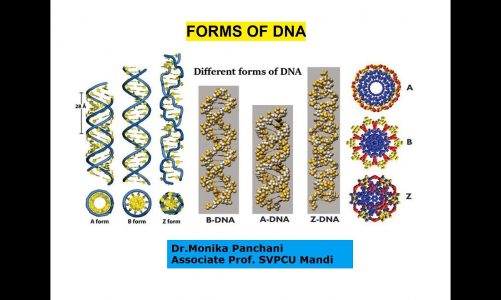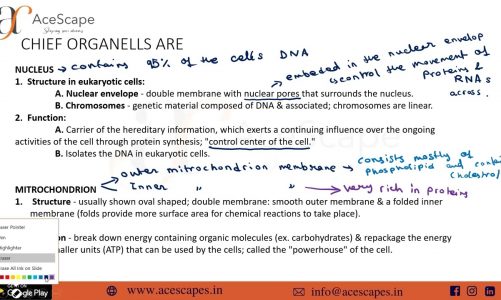| POINTER SESSION |
00:00 Unit 3-Fundamental Process (Molecular Biology)
07:38There are 6000 genes in yeast; 21,700 in a nematode worm; 17,000 in a fly; 25,000 in the small plant Arabidopsis; and probably 20,000 to 25,000 in mice and humans.
09:41The “introns early” hypothesis is the proposal that introns have always been an integral part of the gene.
Genes originated as interrupted structures, and those now without introns have lost them in the course of evolution.
10:36 The “introns late” hypothesis is the proposal that the ancestral protein-coding sequences were uninterrupted and that introns were subsequently inserted into them.
12:28 Pathogenicity islands are a characteristic feature of pathogenic bacteria genomes.
14:28 Pathogenicity islands GC content often differs from that of the rest of the genome, and it is likely that these regions are spread among bacteria by a process of horizontal transfer.
15:49 Bacillus anthracis has two large plasmids (extrachromosomal DNA molecules), one of which has a pathogenicity island that includes the gene encoding the anthrax toxin.
21:03 E. coli have average polypeptide lengths 317 amino acids, S. cerevisiae- 484 and C. elegans – 442 have average polypeptide lengths
23:40 The sum of the number of unique genes and the number of gene families is an estimate of the number of types of genes.
39:46 The largest component of the human genome consists of transposons.
40:36 Genes are not uniformly distributed in the genome.
43:45 The Y chromosome has 60 genes that are expressed specifically in the testis.
44:45 Not all genes are essential. In yeast and flies, deletions of 50% of the genes have detectable effects.
46:43 Most known genetic defects in human genes are due to point mutations. The majority directly affect the protein sequence.
49:59 Deletion appears to have no effect when genes are present in multiple copies called as gene redundancy
50:37 Genetic redundancy means that two or more genes are performing the same function and that inactivation of one of these genes has little or no effect on the biological phenotype.
53:42 Deletions in two genes, neither of which is lethal by itself, are introduced into the same strain. If the double mutant dies, the strain is called a synthetic lethal.
1:01:39 In any particular cell, most genes are expressed at a low level.
1:04:20 The proportion of DNA containing protein-coding genes being expressed in a specific cell at a specific time can be determined by the amount of the DNA that can hybridize with the mRNAs isolated from that cell called as RoT analysis
1:06:01 Reassociation kinetics of an RNA population with cDNA is called Rot1/2 analysis or Rot values (RNA concentration X time)
1:11:57 repetitive DNA (or satellite DNA) has a very short repeating sequence and no coding function.
1:17:39 Many genes are arranged along the chromosomes in groups of related genes. These groups are called gene clusters.
1:24:06 Thalassemias result from occurrence of unequal crossing that reduce or prevent synthesis of either a- or b-globin.
1:25:34 When a genome contains a cluster of genes with related sequences, mispairing between nonallelic loci can cause unequal crossing over. This produces a deletion in one recombinant chromosome and a corresponding duplication in the other.
1:27:12 Different thalassemias are caused by various deletions that eliminate a- or b-globin genes. The severity of the disease depends on the individual deletion.
1:29:36 Depending on the diploid combination of thalassemic alleles, an affected individual may have any number of a chains from zero to three.
1:29:59 if an individual has only one a gene, the excess b chains form the unusual tetramer b4, which causes hemoglobin H (HbH) disease. The complete absence of a genes results in hydrops fetalis, which is fatal at or before birth.
1:33:06 Hb anti-Lepore, Hb Kenya result from unequal crossing over between linked genes.
1:33:38 Ribosomal RNA is encoded by a large number of identical genes that are tandemly repeated to form one or more clusters called as rDNA cluster
1:41:00 The C-value paradox refers to the lack of correlation between genome size and genetic and morphological complexity
1:41:45 Genome is constant value or remain constant till new evolution break called C-Value sometimes G-value
1:43:06 Part of genome which changes expression of genome called as mutable loci or sometimes GENES.
1:43:55 Exceptionally Amphibians and some flowering plants have greater amount of genome hence termed as PARADOX or C-Value Paradox
1:44:21 Disparity in genome content vs evolutionary status is called as C-Value Paradox.
1:44:55 Drosophila melanogaster also shows C-Value paradox in terms of their number of genes.
1:44:59 Consider 1000 bp DNA.
• 500 bp is sequence a, present in a single copy.
• 500 bp is sequence b (100 bp) repeated 5 times:
source
1000 Points Series | Unit-3 Fundamental Process | Molecular Biology | Dr. Ashish Kr Dwivedi



